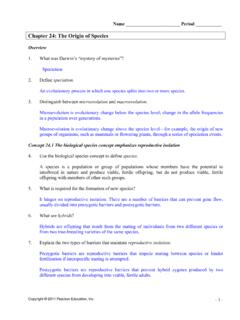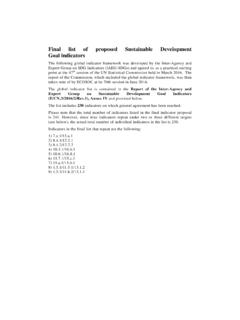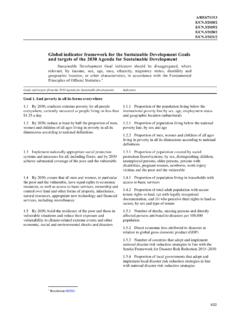Transcription of CHAPTER 3 Breeds, Types, and Classes of Horses
1 Through selection, inbreeding, and outcrossing, humans created Horses for speed,strength, endurance, size, good nature, hardiness, beauty, and athletic ability. Today,over 300 breeds exist. These breeds represent numerous types and Classes . The variousbreeds and types of Horses are also bred to donkeys to produce different types of CHAPTER acquaints the reader with the breeds of Horses and the methods and termsused to group the completing this CHAPTER , you should be able to: Describe how horse breeds started with foundation stallions Understand the concept of breed , types, and classifications Describe the common height measurement for Horses Define the terms warmblood, coldblood, cob,and hack Name 10 common breeds of light Horses and their origin Name five common breeds of draft Horses and their origin Name five common breeds of ponies and their origin List five color breeds of Horses Name five lesser-known breeds of Horses or ponies and their origin Explain the origin of feral Horses Describe how mules are producedCHAPTER 3 Breeds, Types, andClasses of Horses51 Identify the common breeds of donkeys List 10 uses for Horses Describe some of the uses for the miniature donkeys and Horses List six uses for mulesKEY TERMSBREEDST hrough selective breeding, people learned to develop specific desirable charac-teristics in a group of Horses .
2 After a few generations of selective breeding a breedof horse was breed of Horses is a group of Horses with a common ancestry that breed trueto produce common characteristics such as function, conformation, and truemeans that the offspring will almost always possess the same char- acteristics as the breeds of Horses have an association with a stud book and breed -ing records. Many recognized breeds have certain foundation siresand all regis-tered foals must trace their ancestry back to these stallions. For example, the threefoundation stallions of the Thoroughbred are the Darley Arabian, the ByerlyTurk, and the Godolphin Arabian. Justin Morgan is the foundation sire of theMorgan horse breed . Allen F-1, a Morganstallion, is the foundation sire of the Ten-nessee walking horse. Morgan horse stal-lions also contributed to the developmentof the Standardbred, quarter horse, Amer-ican albino, and the palomino who found particular colorsappealing established registries with colorrequirements.
3 Some of these registriesrequire only color for registration, but oth-ers have conformation standards as truebreed registriescobcoldbloodcolor breedconformationdraft horsesferalfoundation sireshackhandhinnyjennetlight horsesminiaturemustangsponyroadsterswarm blood52 KCHAPTER 3 FIGURE 3 1 Appaloosa. (Courtesy ofAppaloosa Horse Club, Inc., ID)The Palomino Horse Association of California was the first color breedregistra-tion. Other color breed registries now include the Appaloosas (see Figure 3 1),albinos, paints, pintos, buckskins, whites, cremes, and spotteds. Color breeds donot breed true. Table A 16 in the Appendix lists the names and addresses of manybreed AND TYPESIn addition to breed , Horses can be classified several different ways. For example, Horses can be grouped as light, draft, or pony, according to size, weight, and these groupings Horses can be further divided by use, for example, rid-ing, racing, driving, jumping, or utility.
4 They can also be classified as warmblood,coldblood, or classifications depend on the height and weight of the horse. Thecommon measurement of horse height is the hand. The height of a horse is mea-sured from the top of the withers to the ground. A hand is equal to 4 inches. So ahorse that is 15 hands is 60 inches. A horse that is (15 hands 2 inches) is62 inches tall from the top of the withers to the HorsesLight horsesare 12 to hands high (hh) and weigh 900 to 1,400 are used primarily for riding, driving, showing, racing, or utility on a farmor ranch. Light Horses are capable of more action and greater speed than HorsesDraft Horses are to hands high and weigh 1,400 pounds or more. Theyare primarily used for heavy work or pulling loads. Historically, when draft horseswere bought and sold for work, they were classified accordingto their use as draft, wagon, farm chucks, or stand hands high or less and weigh 500 to 900pounds.
5 Ponies possess a distinct conformation on a reducedscale. They are either draft, heavy harness, or saddle type(see Figure 3 2).WarmbloodWarmblood does not relate to Horses with a certain blood tem-perature. It refers to the overall temperament of light-to-Breeds, Types, and Classes of HorsesK53 FIGURE 3 2A Welsh pony stallion.(Photo courtesy of Welsh Pony and CobSociety of America, Winchester, VA)medium horse breeds. Warmblood Horses are fine-boned and suitable for riding. Insome countries, the warmblood is distinguished as a horse having a strain of Arabbreeding. Some groupings classify all light Horses as warmbloods. According tosome, all breeds that are not definitely Thoroughbred, draft, or pony are classifiedas Horses are heavy, solid, strong Horses with a calm temperament. Thisterm is probably best thought of as another way of describing draft and UsesTypes of light Horses include riding, racing,showing, driving, all-purpose, and minia-ture.
6 Riding Horses are generally thought ofas the gaited Horses (three- and five-gait),stock Horses , Horses for equine sports, andponies for riding and driving. Racing horsesare running racehorses, pacing/trotting race- Horses , quarter racehorses, and harnessracehorses (see Figure 3 3). Driving horsesinclude the heavy and fine harness Horses ,ponies, and the roadsters. All-purposehorses and ponies are used for family enjoy-ment, showing, ranch work, etc. Miniaturehorses and donkeys are used for driving andas , some breeds fit better intosome of these types than other terms coband hackare also used to describe types of Horses . A cob is asturdy, placid horse. It stands to hands high and is not heavy or coarseenough to be classified as a draft animal. A hack is an enjoyable, good ridingor driving horse, sometimes considered a small Thoroughbred in Europe or asaddlebred in BREEDS OF HORSEST able 3 1 briefly describes some of the more common breeds of Horses , their ori-gin, classification, and height.
7 Table 3 2 lists some of the less well-known breedsof warmblood or light Horses and their origin. Table 3 3 lists some other breeds ofdraft or coldblood Horses and their origin, while Table 3 4 provides the name andorigin of some lesser-known breeds of ponies and their 3 FIGURE 3 3 Standardbred trotter Colonial Charm. (Courtesy of UnitedStates Trotting Association, OH)MINIATURE HORSESM iniature Horses are scaled-down versions of a full-size horse and are not are not a breed but can be registered with the Miniature Horse Reg-istry. The maximum height for registration is 34 inches at the are often kept as pets. Some are exhibited as driving Horses insingle pleasure and roadster driving Classes . Also, some people exhibit miniaturehorses in multiple hitches pulling miniature wagons, stagecoaches, and of their size, only a small child can ride them (see Figure 3 4).RARE BREEDSSome breeds are threatened because American agriculture has changed.
8 Many tra-ditional livestock breeds have lost popularity and are threatened with traditional breeds are an essential part of the American agricultural inheri-tance. They evoke our past and represent an important resource for the Earth s bio-diversity in the future. Rare breeds are classified by the American Livestock breed is considered rare if there are fewer than 1,000 NorthAmerican registrations and fewer than 5,000 estimated worldwide on an annualbasis. According to this definition the following Horses are considered rare breeds: Canadian DartmoorBreeds, Types, and Classes of HorsesK55 FIGURE 3 4 Miniature horse pulling a cart at the Boise Horse Show. Hackney Lipizzaner Rocky MountainA breed is classified as critical by the American Livestock Breeds Conser-vancy when that breed is on the verge of being lost. The critical category meansthere are fewer than 200 North American annual registrations and fewer than 2,000estimated worldwide.
9 Horses classified as critical breeds include the following: Akhal Teke American Cream Caspian Cleveland Bay56 KCHAPTER 3 One Horse Is Most Remembered Man o WarMan o War was not just anotherracehorse. Man o War was one of1,680 Thoroughbreds foaled in was born on March 29 at the KentuckyNursery Stud owned by August Belmont o War s sire was Fair Play, by Hastings. Toprovide balance to Fair Play s temper, Belmontbred him to Mahubah, by Rock Sand, whohad won the British Triple Crown. named the foal My Man o War, since he was a war baby. Belmont had to servein the Army in 1918, so he ordered his entirecrop of yearlings sold at Saratoga, Man o War was bought byPennsylvania horseman Samuel Riddle for$5,000 and shipped to Riddle s training farm, Glen Riddle, in Maryland. Man o War wastrained by Louis Feustel who had trainedMahubah, Fair Play, and Hastings. When hewas sent off to his first race at Belmont Park, aretired hunter named Major Treat accompa-nied him and would continue to travel withMan o War throughout his racing June 6, 1919, ridden by Johnny Loftus,Man o War won his first race by six lengths,crossing the finish line at a canter.
10 He showedhis desire to be a front-runner and never likedto have any other horse in front of him. He ranonly in expensive stake races for the remainderof his career. As his wins built up, so did theweight he was required to carry. By his fourthrace, Man o War was carrying 130 sixth race was the Sanford Memorialand the only defeat of his career. A bad startleft him with a 10-length deficit and once hecaught the pack he was boxed in. He wasbeaten by a horse ironically named o War had beaten Upset on six otheroccasions. In spite of this lone defeat, he wasselected Horse of the Year at the end of his2-year-old o War went undefeated as a 3-year-old in 1920, and reduced the Americanrecord for the mile by 2 5of a second, to1:354 5; and even at that, his jockey, ClarenceKummer, had held him back. Later, in the Exmoor Florida Cracker Mountain Pleasure Spanish Mustang Spanish Barb SuffolkThe American Livestock Breeds Conservancy also classifies breeds as watch and study, which represent progressions toward the rare or critical are classified as recovering when individuals or organizations have takeninitiative to save a rare or critical , Types, and Classes of HorsesK57 Belmont Stakes, he set a record that stood for50 years.







